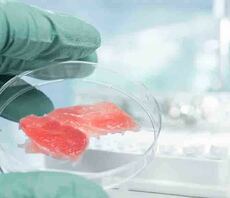

New report highlights the environmental opportunities associated with cultivated meat, but warns there are a number of legislative challenges to be overcome
The cultivated meat industry has potential to deliver numerous environmental and health benefits, but the sector will struggle to attract investment and sustain growth unless it is supported by both effective regulations and consensus-based standards.
That is the headline recommendation contained in a new report on the nascent cultivated meat sector from the British Standards Institution (BSI), titled The future of sustainable alternative proteins: cultivated meats which was published this week.
The report argues that in the future cultivated meat will complement, rather than fully replace traditional meat. However, if the sector is to thrive and maximise its potential environmental benefits then there are a number of financial and technical challenges which need to be overcome.
The report defines a cultivated meat as one which has been produced using tissue engineering techniques that have been pioneered in regenerative medicine.
The sector has developed rapidly over the past decade. In 2013, the first hamburger patty was grown from animal cells. In 2020, the world's first cell-cultured meat went on sale at Singaporean restaurant called 1880 Singapore.
The industry is attracting investment as new technologies for cultivating meat are emerging and start ups edge towards commercialisation. According to the Good Food Institute, in 2021 cultivated meat companies attracted $140m of investment in Europe.
However, the report warns the industry is still a long way from being commercially viable, as well as being acceptable to consumers.
"As with many developing technologies getting from lab to market is a major challenge," said Sara Wilson, sector lead for agri-food at BSI. "In such markets, the development of standards can play a vital role in turning innovation into reality."
The report argues legislation will have a huge role to play in the future of cultivated meats, as effective rules are reqiured to reassure customers that cultivated meats can be ethically produced and safe to eat. It compares the sector with the pharmaceutical and cosmetics industries, where products are often developed under highly controlled laboratory conditions - a process which it argues gives consumers confidence products are safe to use.
The report argues that similar standards will be "vital" in creating consumer trust around cultivated meats, and that their development should be accompanied by key stakeholders agreeing which language and terminology should be used to describe the sector.
In order for cultivated meat companies to attract investment, the report advises that the industry needs to be supported by appropriate frameworks - both regulation and consensus-based expert standards as designed by industry, research bodies, and other key stakeholders.
The BSI report drew comparisons with the electric vehicle industry, where it said the early emergence of standards helped create the 'scaffolding' which has enabled investment in EV and charging innovations.
If these legislative challenges can be overcome the BSI said there could be huge environmental and financial benefits from creating a food industry which is not so reliant on land and natural resources, is more efficient, and has a vastly reduced carbon footprint.
According to figures from ReportLinker, the cultivated meat market is expected to grow be worth more than $319.8m (£265m) in the next six years, representing a market growth rate of 10.2 per cent.
The environmental benefits of cultivated meat were also highlighted by industry insiders in the report. Cai Linton, the co-founder and chief executive officer of biotech company Multus, estimates that land-usage, water-usage, and greenhouse gas emissions associated with cultivated meat could be as much as 90 per cent lower than cattle farming, adding that although energy is still required to produce cultivated meat - such as power for production plants - this could be sourced in renewable ways.
"When you're growing a cow in a field, you have to grow the whole cow," he explained. "Cows are essentially being used as a factory for meat production but that is not their natural purpose. Whereas with cultivated meat, companies are growing the meat tissues that we want to consume and we provide the cells with the exact nutrients and environment that they need to grow."
Callum Murray, head of agriculture and food at Innovate UK, also acknowledged the challenge the agriculture industry is facing as it seeks to deliver on net zero goals, which represents a major opportunity for cultivated meats. "This suggests there is a market for alternative protein products that mitigate this, and that there is potentially a way for concerned consumers to find a way of consuming meat without the associated emissions," he observed.
Clare Trippett, chief technologist at innovation catalyst CPI, estimated the impacts from conventional animal agriculture are said to be responsible for 14-18 per cent of all greenhouse gas emissions. She said that most people focus on the land and water use when determining the GHG of agriculture, but said that often people forget to consider other knock on effects, such as the soya used to feed the animals and the transport emissions associated with such feedstocks.
"Part of the problem with conventional meat is that animals are a really inefficient way of producing food for us to eat," she added. "It takes something like a chicken, which is quite well optimised, to eat 9 calories to produce one calorie of food, versus a cow, where it takes 20 calories to produce one calorie."
Jonathan Rand, who is part of the biotechnology business unit at CPI, agreed that reducing the amount of farmland used for animal agriculture by using more cultivated meats could have a "massive" impact on the wider environment.
"Seventy-seven per cent of farmland is utilised by either providing the feed for the animals or grazing the animals, which puts incredible pressure on our food system," he added. "Similarly, chickens in the UK are largely fed on soya which is often imported from South America. It's that carbon footprint which feels ridiculous but is the reality of our global food system."
The report from BSI comes in the same week as a separate academic study was published in the journal Nature Climate Change, which calculated that the food industry alone would push the world past 1.5C warming unless urgent action is taken to tackle methane-intensive foods, such as red meat.
In order to help realise the environmental benefits of cultivated meats and accelerate the development of effective legislation and standards, Linton argued a professional body for the cultivated meat industry was urgently needed.
Murray added that the regulatory environment must also be sensitively delivered by key players, such as the Department for Environment, Food and Rural Affairs and the Food Standards Agency so as to facilitate the development technology which will allow the UK to remain competitive in this sector.
Trippet warned "one of the major challenges will be around making sure the manufacturing process is clean and sustainable - We can't replace one problem with another".
In the future, cultivated meat could ease the strain on global food systems, but overall the report suggested that it would not replace traditional meat in its entirety.
"Over time, the bulk of what is currently factory-farmed meat will become cultivated meat and there will still be a large market for more locally produced and high-standard meat products," predicted Linton.
Murray agreed that for the time being, and until wider changes to the agricultural industry are made, the cultivated meat market will only have a modest impact on the wider meat industry. "But, it could add an alternative product line to those who want to continue to eat meat, but without the associated concerns of the slaughter process in livestock systems," he added. But he also acknowledged that the potential was there for more fundamental reforms that could play a key role in the net zero transition. "In the longer term, if the economic and environmental considerations become compelling then it could also allow for some land to be released for other forms of carbon capture and storage," he added.
The cultivated meat sector has the potential to be genuinely transformational, but only if regulators, standards bodies, investors, and entrepreneurs move quickly to establish the standards and regulations that can tear down the barriers the industry will inevitably face as it scales up.
* This article was originally published here
Comments
Post a Comment